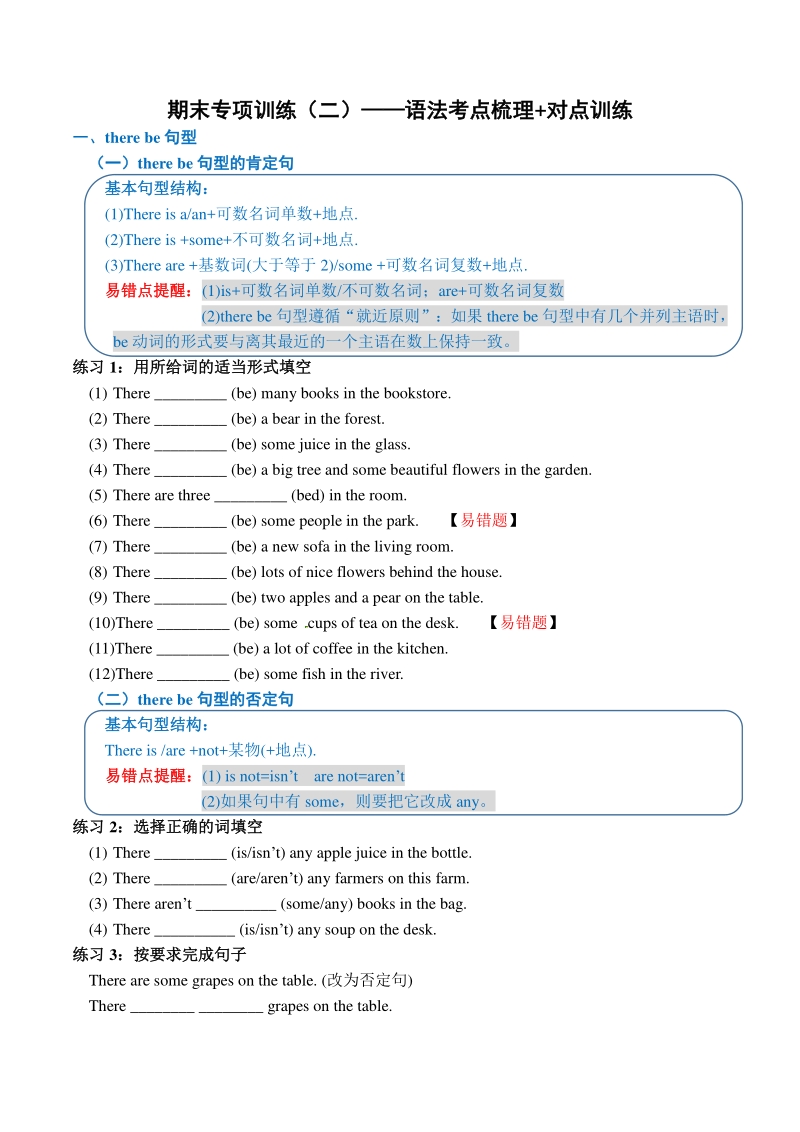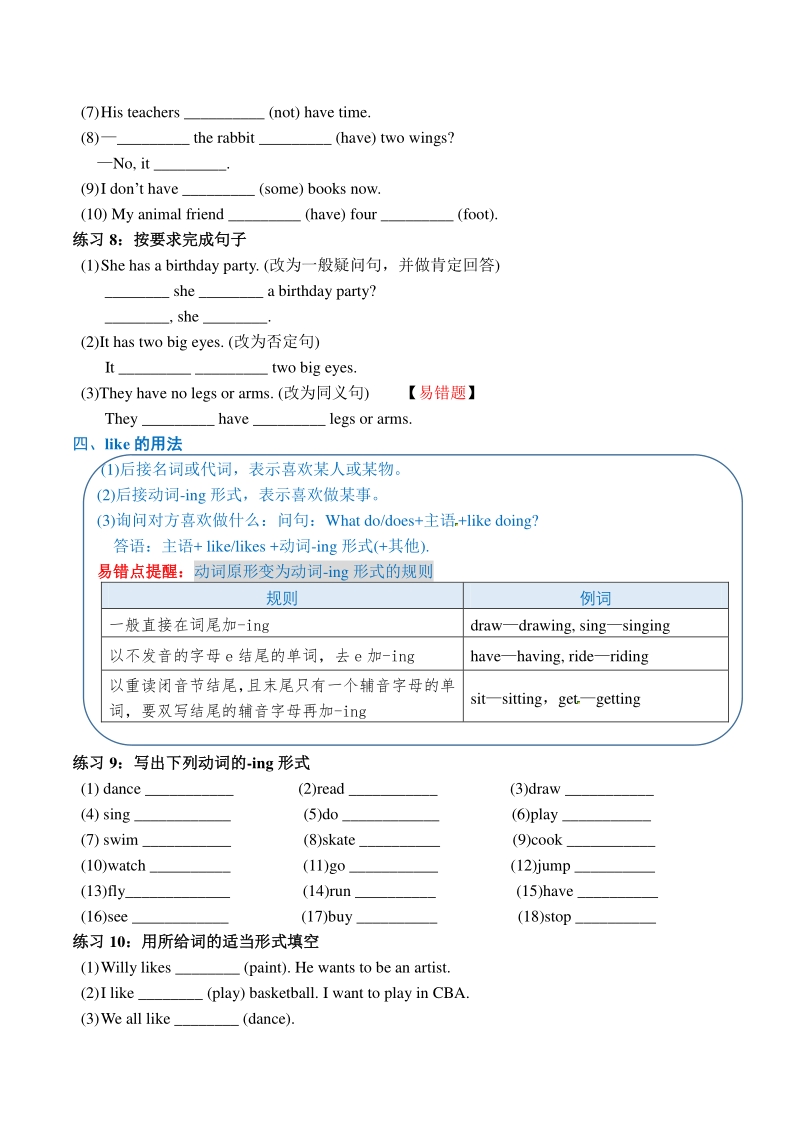 2021年译林版五年级上册英语期末专项训练(二)语法考点梳理精讲+对点跟踪训练(含答案)
2021年译林版五年级上册英语期末专项训练(二)语法考点梳理精讲+对点跟踪训练(含答案)
《2021年译林版五年级上册英语期末专项训练(二)语法考点梳理精讲+对点跟踪训练(含答案)》由会员分享,可在线阅读,更多相关《2021年译林版五年级上册英语期末专项训练(二)语法考点梳理精讲+对点跟踪训练(含答案)(9页珍藏版)》请在七七文库上搜索。
1、期末专项训练(二)期末专项训练(二)语法语法考点梳理考点梳理+对点训练对点训练 一、there be 句型句型 (一)(一)there be 句型句型的肯定句的肯定句 基本句型结构:基本句型结构: (1)There is a/an+可数名词单数+地点. (2)There is +some+不可数名词+地点. (3)There are +基数词(大于等于 2)/some +可数名词复数+地点. 易错点提醒:易错点提醒:(1)is+可数名词单数/不可数名词;are+可数名词复数 (2)there be 句型遵循“就近原则”:如果 there be 句型中有几个并列主语时, be 动词的形式要与离其
2、最近的一个主语在数上保持一致。 练习练习 1:用所给词的适当形式填空用所给词的适当形式填空 (1) There _ (be) many books in the bookstore. (2) There _ (be) a bear in the forest. (3) There _ (be) some juice in the glass. (4) There _ (be) a big tree and some beautiful flowers in the garden. (5) There are three _ (bed) in the room. (6) There _ (be)
3、 some people in the park. 【易错题】 (7) There _ (be) a new sofa in the living room. (8) There _ (be) lots of nice flowers behind the house. (9) There _ (be) two apples and a pear on the table. (10)There _ (be) some cups of tea on the desk. 【易错题】 (11)There _ (be) a lot of coffee in the kitchen. (12)There
4、 _ (be) some fish in the river. (二)(二)there be 句型的否定句句型的否定句 基本句型结构:基本句型结构: There is /are +not+某物(+地点). 易错点提醒:易错点提醒:(1) is not=isnt are not=arent (2)如果句中有 some,则要把它改成 any。 练习练习 2:选择正确的词填空选择正确的词填空 (1) There _ (is/isnt) any apple juice in the bottle. (2) There _ (are/arent) any farmers on this farm. (3
5、) There arent _ (some/any) books in the bag. (4) There _ (is/isnt) any soup on the desk. 练习练习 3:按要求完成句子按要求完成句子 There are some grapes on the table. (改为否定句) There _ _ grapes on the table. (三)(三)there be 句型的一般疑问句句型的一般疑问句 基本句型结构:基本句型结构: 问句:Is there/ Are there any +某物(+地点)? 肯定回答:Yes, there is/are. 否定回答:N
6、o, there isnt/arent. 易错点提醒:易错点提醒:如果句中有 some,则要把它改成 any。 练习练习 4:选择正确的词填空选择正确的词填空 (1) _ (Is/Are) there any beds in the room? (2) _ (Is/Are) there any water in the bottle? Yes, there _ (is/are). (3) Are there _ (some/any) people in the living room? 练习练习 5:按要求完成句子按要求完成句子 (1)There is a playground in my s
7、chool. (改为一般疑问句) _ _ a playground in _ school? (2)There are some hamburgers on the table. (改为一般疑问句并做否定回答) _ there _ hamburgers on the table? _, there _. 二、询问可数名词的数量询问可数名词的数量 问句句型结构:How many +可数名词复数+are there(+地点)? 答语:There is/are+基数词(+其他). / 基数词. 易错点提醒:易错点提醒:how many 意为“多少”,后接可数名词的复数形式。 练习练习 6:选择正确的
8、词填空选择正确的词填空 (1) How many _ (classroom/classrooms) are there in your school? (2) How _ (many/much) people are there in the park? 三、have 和和 has 的区别的区别 have 和 has 都表示“拥有;具有”,has 是 have 的第三人称单数形式。它们的区别如下: (1) 当主语是第三人称单数(he, she, it 及单数名词)时,要用 has。 (2) 当主语不是第三人称单数,即为 I, we, you, they 及复数名词等时,要用 have。 (3)
9、 否定句式:一般要先加助动词 do/does,再加 not。 (4) 一般疑问句句式:问句:Do/Does+主语+have+宾语? 肯定回答:Yes, do/does. 否定回答:No, dont/doesnt. 练习练习 7:用所给词的适当形式填空用所给词的适当形式填空 (1) I _ a toy dog. It _ a strong body. (have) 【易错题】 (2) The dog _ (have) four legs. (3) The boy doesnt _ (have) a robot. He _ (have) a toy car. (4) Su Hai and Su Y
10、ang _ (have) a dancing lesson. (5) _ you _ (have) a bike? (6) She _ _ (not have) any pencils. (7) His teachers _ (not) have time. (8) _ the rabbit _ (have) two wings? No, it _. (9) I dont have _ (some) books now. (10) My animal friend _ (have) four _ (foot). 练习练习 8:按要求完成句子按要求完成句子 (1) She has a birth
11、day party. (改为一般疑问句,并做肯定回答) _ she _ a birthday party? _, she _. (2)It has two big eyes. (改为否定句) It _ _ two big eyes. (3)They have no legs or arms. (改为同义句) 【易错题】 They _ have _ legs or arms. 四、like 的用法的用法 (1)后接名词或代词,表示喜欢某人或某物。 (2)后接动词-ing 形式,表示喜欢做某事。 (3)询问对方喜欢做什么:问句:What do/does+主语+like doing? 答语:主语+
12、like/likes +动词-ing 形式(+其他). 易错点提醒:易错点提醒:动词原形变为动词-ing 形式的规则 规则 例词 一般直接在词尾加-ing drawdrawing, singsinging 以不发音的字母 e 结尾的单词,去 e 加-ing havehaving, rideriding 以重读闭音节结尾, 且末尾只有一个辅音字母的单 词,要双写结尾的辅音字母再加-ing sitsitting,getgetting 练习练习 9:写出下列动词的:写出下列动词的-ing 形式形式 (1) dance _ (2)read _ (3)draw _ (4) sing _ (5)do _
13、(6)play _ (7) swim _ (8)skate _ (9)cook _ (10)watch _ (11)go _ (12)jump _ (13)fly_ (14)run _ (15)have _ (16)see _ (17)buy _ (18)stop _ 练习练习 10:用所给词的适当形式填空用所给词的适当形式填空 (1) Willy likes _ (paint). He wants to be an artist. (2) I like _ (play) basketball. I want to play in CBA. (3) We all like _ (dance).
14、 (4) I like _ (eat) mangoes. (5) Tom _ (like) _ (swim), but he _ (not like) _ (climb). (6) What _ he like _? (do) (7) _ you _ (like) _ (read)? 练习练习 11:按要求完成句子按要求完成句子 (1) She likes playing table tennis. (对画线部分提问) _ _ she like _? (2)Tom likes swimming. Sam likes swimming too. (合并为一句) Tom and Sam _ _ s
15、wimming. (3)Helen likes singing and dancing. (改为一般疑问句,并做否定回答) 【易错题】 _ Helen _ singing _ dancing? _, _ _. 五、be good at (1)be good at 意为“擅长”,其后可以接名词、代词或动词的-ing 形式。 (2)改为否定句时,直接在 be 动词后面加 not 即可。 练习练习 12:单项选择单项选择 ( )(1)His grandfather is good at _. A. swim B. swiming C. swimming ( )(2)Nancy is good at
16、_. A. England B. English C. study 练习练习 13:根据中文意思翻译句子:根据中文意思翻译句子 王兵不擅长溜冰。 Wang Bing is _ good _ _. 六、Its time for 句型“Its time for”是提醒某人该做某事的常用句型,意为“是该的时候了”。同 义句型为“Its time to do” 练习练习 14:用所给词的适当形式填空用所给词的适当形式填空 It time _ (have) dinner. 练习练习 15:同义句转换:同义句转换 Its time for school. Its time _ _ _ school. 七、
17、动词第三人称单数的变化规则动词第三人称单数的变化规则 规则 例词 一般情况下,直接在动词词尾加-s looklooks, runruns, likelikes 以元音字母(a, e, i, o, u)加 y 结尾的动词,直接 在动词词尾加-s playplays, staystays 以辅音字母加 y 结尾的动词,把 y 改成 i,再加-es studystudies, worryworries 以-s, -sh, -ch, -x 或-o 结尾的动词,一般在词尾 加-es passpasses,mixmixes 特殊的不规则变化 havehas 练习练习 16:写出下列动词的:写出下列动词的第
18、三人称单数第三人称单数形式形式 (1) wash _ (2)want_ (3)have _ (4) go _ (5)do _ (6)play _ (7) teach _ (8)watch_ (9)cook _ (10)fly _ (11)work _ (12)drive _ (13)ride_ (14)read_ (15)write_ (16)send _ (17)like _ (18)help _ 八、询问职业询问职业 1. 用句型“What do/does+主语+do?”来询问别人的职业。答语为“主语+be 动词+a/an+ 职业名词.”。 2. 其他询问职业的句型:(1) What is
19、+主语(第三人称单数)? (2) Whats +形容词性物主代词/名词所有格+job? 练习练习 17:单项选择单项选择 ( )(1)_ Im a cook. I can cook nice food. A. What is that? B. What do you do? C. Are you a driver? ( )(2)What _ Mr Wang do? Hes a _. He helps sick people. A. does; doctor B. do; doctor C. is; nurse 练习练习 18:用所给词的适当形式填空用所给词的适当形式填空 (1) What _



- 配套讲稿:
如PPT文件的首页显示word图标,表示该PPT已包含配套word讲稿。双击word图标可打开word文档。
- 特殊限制:
部分文档作品中含有的国旗、国徽等图片,仅作为作品整体效果示例展示,禁止商用。设计者仅对作品中独创性部分享有著作权。
- 关 键 词:
- 2021 年译林版五 年级 上册 英语 期末 专项 训练 语法 考点 梳理 跟踪 答案
 七七文库所有资源均是用户自行上传分享,仅供网友学习交流,未经上传用户书面授权,请勿作他用。
七七文库所有资源均是用户自行上传分享,仅供网友学习交流,未经上传用户书面授权,请勿作他用。



 浙公网安备33030202001339号
浙公网安备33030202001339号
链接地址:https://www.77wenku.com/p-168498.html